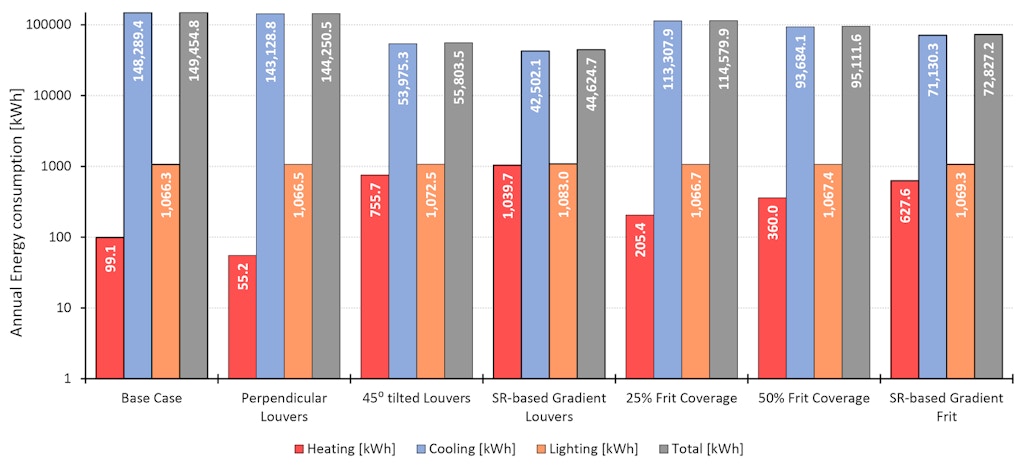Data-Driven Shading Systems
Application for Freeform Glass Facades
Sign in and Register
Create an Account
Overview
Abstract
Analyzing the energy performance of complex building envelopes, determining the need for sun protection, and assessing the effectiveness of shading devices is a difficult problem. Modeling the complex geometry of facades and shading systems is very cumbersome and usually leads to computationally expensive energy simulations that cannot easily be integrated during the early stages of the design process.Aiming to improve the workflow of modeling and energy simulation, this paper presents a new approach that couplesparametric design with Building Energy Models (BEMs). The proposed method integrates different abstraction and datasimplification processes that convert geometrical parameters of shading systems into thermal and optical glazing properties and thus accelerate building energy simulations. This way, it becomes possible to use results from energy simulations at early design phases and compare, for example, different shading devices or customize solutions to specific facade constraints. To illustrate the potential of this approach, the paper will briefly summarize the general challenges related to shading free form facades and discuss an exemplary envelope in more detail. By mapping incident solar radiation, the authors will show that each facade panel is not only irregular in shape but also unique regarding its solar exposure and resulting shading requirements. This information can be used to assign custom panel properties and inform the shape, orientation, and distribution of common shading devices like glass frits or externally mounted louvers. Finally, by comparing multiple shading solutions, the paper will show how this design process can significantly reduce the facade’s cooling demands.
Authors

Simon Schleicher
University of California, Berkeley
simon_s@berkeley.edu

Luis Santos
University of California, Berkeley
luis_sds82@berkeley.edu

Luisa Caldas
Professor
University of California, Berkeley
lcaldas@berkeley.edu
Keywords
Introduction
The fact that the building sector is responsible for nearly half (44.6%) of U.S. CO2 emissions, calls for immediate and sustained action (EIA, 2012). Thus, transforming the way buildings are designed, built, and operated is a primary concern nowadays. One of the most effective ways to reduce CO2 emissions in buildings is reducing the need for artificial heating, cooling and lighting. In the case of freeform glass facades, the problem of overheating that leads to high cooling demands is particularly acute, especially in temperate and hot climates. With the rise of computational tools, complex building envelopes have become increasingly popular and are used, for example, in airports, museums, and mixed-use high-rise buildings. Protecting a freeform glass facade from the sun, however, is a particularly challenging task for various reasons: On the one hand, due to its irregular geometry, one cannot easily apply standard off-the-shelf shading devices but relies on highly customized tailored solutions. On the other hand, the complex panelization makes it very difficult to determine a facade’s demand for shading and to assess the efficiency of shades. Thus, it is not uncommon that developers try to avoid high acquisition costs and plan freeform facades either without any sun protection or with only a rudimentary knowledge about their effectiveness. However, neither strategy offers a real solution, since a total lack or inefficient sun protection results in user-unfriendly buildings, which constantly require energy-intensive artificial cooling. Motivated by this problem, the goal for this paper is to improve the energy efficiency of freeform glass facades by investigating a new approach for the design and evaluation of data-driven static shading systems.
Background
One of the current limits in the design of shading systems for freeform facades is the difficulty to assess their energy performance. Digital simulations must consider not only the location of the building, its orientation, and sun exposure, but also need to incorporate the envelope’s complex and irregular panelization. Additionally, describing the geometry of the shading device and the effects created by it makes this task even more challenging. All aspects together quickly result in time-consuming modeling tasks and in computationally intensive simulations. As a result, the slow energy simulations are unfortunately often moved to a post-design stage where they have less influence on the building design. Since the goal for this paper is to integrate energy simulations in early design stages, new streamlined workflows need to be developed that by abstracting and simplifying data inputs accelerate simulations and deliver useful information to steer the design process in its early development.
To achieve this goal, the authors propose a combination of parametric modeling tools with BEM in a mutually beneficial approach. More precisely, the aim is to improve the data exchange between Grasshopper and Rhinoceros with EnergyPlus (E+), Radiance, and WINDOW 7.5 (Coakley et al. 2014, Ward and Rubinstein 1988, Huizenga et al. 2017). While each of these tools is very powerful, their combination can unleash additional synergy effects. To combine these tools, it is worth having a closer look at some individual strengths and weaknesses. For example, although E+ is a state-of-the-art building energy simulation software, its actual modeling features are very limited in comparison to those provided in Rhinoceros and Grasshopper. Being able to control geometrical parameters and meshing strategies, however, is a very important prerequisite for a successful simulation in E+, especially since this software relies so heavily on mesh planarity. While simple triangulation can help to overcome these limitations, it may also lead to follow-up problems. For instance, mesh triangulation typically results in very dense meshes that exponentially increase simulation time. Such geometrical limitations usually force the designer to manually oversimplify a facade’s geometry whenever an energy simulation is needed. Although, experts have streamlined the manual simplification of model geometry in the past, there are inevitable consequences of this approach: the mismatch between BEM and CAD models; the loss of accuracy, which is particularly relevant for facades that use passive solar design strategies and have a significant amount of self-shaded surface area. It is precisely here where E+ can greatly benefit from the advanced surface modeling and planarization tools offered by Rhinoceros/Grasshopper namely in modeling automation for BEM. Another major advantage of these tools is their parametric modeling capability, which comprises the potential for automatic geometry changes and the creation and comparison of multiple design solutions.
Method
To illustrate the potential of the proposed workflow, the methodology will be applied on a concrete example: a prototypical freeform glass facade on which different shading systems are deployed. The method consists of five steps: firstly, defining a building envelope in Rhinoceros 5.0 and panelizing it in Grasshopper (build 0.9.0076). Secondly, using Radiance to conduct an annual solar radiation analysis and determine the shading needs of each facade panel. Thirdly, using WINDOW 7.5 to convert the geometry of different shading devices like louvers and glass frits into thermal and optical glazing panel properties. The resulting dataset is then used to assign different thermal and optical glazing properties to the individual panels in the façade based on the incident solar radiation already mapped in the building envelope. In the fourth step, E+ (version 8.4) is used to simulate the energy consumption for heating, cooling, and lighting of the thermal zone defined by the enclosed envelope and to compare the energy performance of the different shading systems. Finally, the fifth step takes the data of the energy simulation to re-create the actual geometry of the shading devices back into Rhinoceros/Grasshopper for visual feedback and possible design alterations. Figure 1 illustrates in a flow chart the adopted method. To validate the accuracy of this approach, the team compared the energy performance of two re-created energy models, with detailed shading geometry, and their simplified counterparts. Each step will be described in more detail in the following sections.

Form-Generation and Panelization
To test the proposed method, the team chose an ellipsoidal building as a geometrically challenging case study. This form is interesting because it features deviating surface curvature while being defined by only three parameters. For the meshing, a conformal mapping approach was applied (Sechelmann et al. 2013). This panelization strategy enables a subdivision of the surface into planar mesh faces of different sizes, but similar in shape and angles. The process followed a series of steps: the team began by modeling an ellipsoid of 25x18x7 meters and then generated a net on the surface using the lines of curvature.
Afterwards, a quadrilateral mesh was obtained based on the intersection points of these lines. The resulting mesh consists of completely planar quads, illustrated by the touching inner circles of the mesh faces in Figure 2. The here-achieved mesh planarity is a very important prerequisite for the subsequent energy simulations.

Mapping Annual Solar Radiation
Los Angeles (LA) is the location of the building and its main axis is aligned with the north-south axis. Because the main concern of this paper is to assess the impact of shading in the overall energy performance, the dry warm climate of LA (climate Zone 3B according to ASHRAE) is suitable to conduct this study. Using the typical meteorological year (TMY3) LA file, Radiance is able to calculate the cumulative annual solar radiation (Fig. 3). As expected, the solar exposure of the individual panels varies over the entire facade, which questions a uniform treatment of the facade and instead supports the argument for locally adapted shading solutions. The color gradient shows the annual solar irradiance ranging from 100 to 2000 kWh/m2.

Conversion of Shading Geometry Into Thermal/Optical Glazing Properties
In BEM a glazed facade panel can be modeled using two different procedures: either (i) detailed by specifying each layer of the window or (ii) simplified by describing the glazing assembly through conductivity (U-factor [W/m2K]), Solar Heat Gain Coefficient (SHGC), and Visual Transmittance (VT). Although the detailed modeling of windows delivers more precise results, the simplified description of a glazing system is accurate enough to inform early design stages. Because the goal of this work is to simplify the geometrical features of louver-based shading devices and glass frits, this study adopts the simplified modeling approach. To assess the impact that these shading systems may have on U-factor, SHGC, and VT of a standard glazing assembly, the team used WINDOW 7.5 (Fig. 4). The standard glazing assembly consists of two 6 mm clear glass panes (the same substrate used in WINDOW 7.5 for glass frit calculations) with an air gap of 12 mm. The SHGC for this setup is 0.68, U-factor 2.83 W/m2K, and VT of 0.76 (76%). The louvers are white colored metal and the frit ceramic cover is white with specular and diffuse light distribution data measured in Lawrence Berkeley National Laboratory (LBNL). For the case of the louver-based shading system the ratio between slat spacing and slat width is 1:1 and kept as a constant. By preserving this ratio, it is possible to generate louvers in different size and geometry while keeping the same profile angle and thus the same overall performance.

To compare different shading systems in a systematic way, two types of modifications were investigated in more detail. The louver-based system was tested for various tilt angles in steps of 5º in relation to the axis parallel to the glass plane. The fritbased system was analyzed for different densities in steps of 5% coverage. By post-processing the resulting data it is possible to express the slat tilt angle, frit coverage, and VT as functions of SHGC. Regarding the U-factor the authors observed that the different shading variations did not produce a relevant impact. The only significant change in U-factor was when a louver shading system was added to the standard glazing unit in the first place. With louvers, the U-factor droppedfrom 2.83 to 2.5 W/m2K. After this all variations of the tilted louvers had a negligible impact. The adding of frit to the standard glazing system did not change its U-factor. Thus, the U-factor of all louver shading variations is 2.5 W/m2K while the U-factor of the frit based assemblies is 2.83 W/m2K. Figure 5 and 6 show the linear regression models obtained for the louver- and frit-based shading systems. In both cases the high R2 values indicate a strong correlation between the variables. Thus, these linear models can be used to map SHGC and VT as a function of solar radiation as well as to generate the respective louver and/or frit geometry in relation to a specific SHGC value.


Energy Simulation
This work used E+ to simulate the annual hourly energy consumption for heating, cooling, and lighting of the hemiellipsoid building envelope in LA. The team tested seven different shading conditions (Fig. 7-8):A. Base Case - No shading and standard glazing.
- Base Case - No shading and standard glazing.
- Perpendicular Louvers - all louvers are perpendicular to the glass panel, which corresponds to a tilt angle of 0°.
- 45° tilted Louvers - the glass panels have louvers with a tilt angle of 45°.
- SR based Gradient Louvers - previous studies by Santos et al. (2017) showed that applying a shading density gradient that follows the distribution of Solar Radiation (SR) on the envelope yields significant reduction in cooling energy demands. Thus, for each panel this solution remaps the incident SR to a SHGC value and corresponding tilt
angle of the louver. This remapping is based on a linear interpolation, where the highest SR value relates to the lowest SHGC that the louver-based shading system can reach (0.06), and vice versa. In this way, the louvers of the panels with high SR will be more closed than the ones with low SR. - 25% Frit Coverage - the envelope has a homogeneous frit coverage of 25%.
- 50% Frit Coverage - all panels have a frit coverage of 50%.
- SR based Gradient Frit - the same logic of SR based Gradient Louvers but applied to the frit-based shading system where the range of SHGC only goes from 0.3 to 0.68.


The building was simulated as a single zone energy model with a floor composed of a 200 mm concrete slab plus and a 120 mm XPS insulation board covered with a cement screed resulting in a combined U-factor of 0.28 W/m2K. Table 1 describes the input parameters. The schedules for occupancy, light, and equipment are typical office schedules as provided by ARCHSIM E+ front-end library.

The results of the energy simulation are expressed in annual energy consumption (kWh) per end-use and in Energy Use Intensity (EUI), which normalizes energy consumption per unit area (kWh/m2). In this study, total energy consumption is considered the sum of heating, cooling, and lighting energy. Since the study focuses on the energy performance of the
shading systems, other factors like plug loads or fan energy are not included in the total energy calculation. Finally, to compare the performance of the different shading conditions, the % of improvement in total EUI is calculated as described in (ASHRAE 2013):
% of improvement = 100 x (Base Case EUI - Alternative EUI) / Base Case EUI
Re-Creating the Geometry of the Shading System
Once a correlation between abstracted geometry and glazing properties is established, the process of converting data can also be used in reverse to re-create the three-dimensional features of a shading devices in Grasshopper. The SHGC of each panel can inform, for example, the modeling of a louver-based shading system with specified tilt angles or a frit-based shading system with defined frit coverage. This visual feedback is helpful for the further development of the facade design and allows, for instance, to compare the solutions for their optical effect or to fine-tune design alternatives parametrically (Fig. 9).

Validation
To assess the accuracy of the proposed simplification method, the team compared the energy simulations of two fully detailed re-created solutions with their simplified counterparts. The louver-based shading system was tested in configuration (C), while the frit-based system was tested for solution (F). The validation process is based on three statistical metrics used in energy simulation calibration (Coakley et al. 2014): (i) the Coefficient of Variation of the Root Mean Squared Error (CV RMSE), (ii) the Mean Bias Error (MBE), and (iii) % of error. CV RMSE and MBE use hourly data either for each energy end use or total energy. This paper applied % of error only to assess the deviation in total EUI. The acceptance criteria of CV RMSE and MBE are set out by ASHRAE Guideline 14 (2002) which are 30% and - or + 10% respectively. The acceptance threshold for % of error is 10%. Finally, to assess the cost-benefit of the proposed method the study compares the time of each simulation.
Data
Table 2, shows the summary results of the E+ simulations for all shading alternatives. Figure 10-12 plot the results of the annual energy performance for each individual shading solution. The chart of Figure 10 compares in detail the annual cumulative energy consumption per end-use of all solutions. Due to the cooling outliers, the values are mapped in log10 scale. Through the analysis of Table 2 and Figure 10, it is possible to assess the weight of each energy end-use in the overall energy performance.


Figure 11 shows the total EUI (kWh/m2) per shading solution while Figure 12 the percentage of improvement in total EUI of each shading solution when compared with the EUI of the base case.


Figure 13 and 14 show the validation results. Figure 13 maps out the deviation error of the simplified selected models in terms of CV RMSE and MBE. Figure 14 shows the % of error in total EUI and compares the simulation time of the fully detailed energy models with the simplified ones.


Explanation
Table 2 and Figure 10 show that cooling is the most relevant energy end-use. Even in the best performing case (D), cooling still represents more than 95% of the overall energy consumption. The weight of cooling loads in the energy performance of all cases indicates that it is possible to analyze the energy benefits of shading by analyzing the total energy consumption or the total EUI. As expected, the base case has the worst energy performance due to the overwhelming amount of cooling required to ensure thermal comfort. The adding of perpendicular shades to each panel produces a marginal improvement of only 3.5% (Fig. 12). This is related to the small impact that this shading solution has on the SHGC of the standard glazing unit. In comparison, a relative small percentage of frit coverage produces a bigger impact: an improvement of 23.3% for 25% of frit coverage (Fig. 12). Figure 10 and 11 show that either increasing the louver tilt angle or the frit coverage yields a positive impact in energy performance. Nevertheless, the impact of incrementally closing the louvers by changing their tilt has a bigger impact in decreasing cooling loads than increasing frit coverage would achieve. A closer look at Figure 5 explains this phenomenon: the slope of the linear regression in the louver system is more pronounced than in the frit system, meaning that the tilt angle is more effective in reducing SHGC than frit coverage.
The adaptive shading schemes based on solar radiation present the best results in each shading type, following the pattern observed by Santos et al. (2017). The SR based Gradient Frit (G) improves the energy performance of the base case in 51.3% while the SR based Gradient Louvers (D) yield an outstanding 70.1% improvement, lowering the total EUI from 421.4 kWh/m2 to a reasonable 125.8 kWh/m2. In sum, the louver-based shading systems have the highest potential of reducing cooling loads in fully glazed envelopes. The gradient louvers that were informed by solar radiation values are the most effective in reducing cooling loads at minimal expense of heating and lighting loads.
The validation results show that the proposed simplification of shading geometry is very effective in accelerate energy simulations with a low impact in accuracy. Figure 13 error results are within the acceptable criteria both in the total energy and in all the energy end-uses except for heating. However, heating is of little relevance in the error assessment due to its small weight in the overall energy performance: 1.4% and 0.38% for the louver and frit cases respectively. The % of error in total EUI is also comfortably below the acceptance threshold. The simplified energy models can run 7.5 to 26x faster than the detailed models (Fig. 14) improving the usefulness of energy simulation for complex building geometry in early design phases. Finally, the wide range of simulation acceleration (7.5 to 26x) demonstrates how sensitive numerical energy simulations are to the number of faces of the energy model.
Conclusion and Future Work
This work is a first successful step in improving the design and energy performance evaluation of freeform glass facades with data-driven shading systems. By combining parametric modeling with building energy simulations, the authors presented a streamlined workflow that is fast and accurate enough to inform early design phases. The key innovation of this work is based on the idea to abstract and simplify the geometrical features of the respective shading systems into thermal and optical glazing properties. The application of the proposed method in the design and simulation of louver- and frit-based shading systems for a fully glazed hemiellipsoid delivered accurate results in useful time. Simulating different variations of two shading systems showed that assigning a specific louver tilt or frit coverage to facade panels based on annual incident solar radiation is the most effective strategy to improve the energy performance of fully glazed envelopes with static shading devices. The work also indicates that a more refined study, which would include hourly variation of solar radiation, may have the potential to inform the design and operation of dynamic shading devices that most likely outperform static shading solutions. This particularly true for buildings with continuous envelopes that simultaneously face different orientations, as was
the case for the hemiellipsoid used in this study. Finally, future work should also include the study of more complex shading and/or macroscopic light-redirecting fenestration systems and a refined assessment of annual daylight performance that can complement the energy simulations performed here.
Acknowledgements
Work presented in this paper was partially financed by the Portuguese Science and Technology Foundation (FCT) through the PhD scholarship SFRH/BD/98658/2013. The authors like to thank Constantina Tsiara and Tanya Makker for their help in producing rendered images.
Rights and Permissions
ASHRAE. 2002. “Guideline 14-2002, Measurement of Energy and Demand Savings.” American Society of Heating, Ventilating, and Air Conditioning Engineers, Atlanta, Georgia.
ASHRAE. 2013. ASHRAE Standard 90.1-2013 Determination of Energy Savings: Quantitative Analysis.
Coakley, Daniel, Paul Raftery, and Marcus Keane. 2014. “A Review of Methods to Match Building Energy Simulation Models to Measured Data.” Renewable and Sustainable Energy Reviews 37: 123–141.
Crawley, Drury B., Linda K. Lawrie, Frederick C. Winkelmann, Walter F. Buhl, Y. Joe Huang, Curtis O. Pedersen, Richard K. Strand et al. "EnergyPlus: creating a new-generation building energy simulation program." Energy and buildings 33, no. 4 (2001): 319-331.
Energy Information Administration (US), ed. Annual Energy Outlook 2012: With Projections to 2035. Government Printing Office, 2012.
Huizenga, Charlie, Dariush Arasteh, Charlie Curcija, Joe Klems, Christian Kohler, Robin Mitchell, Tiefeng Yu, et al. 2017. WINDOW 7.5. Lawrence Berkeley National Laboratory.
Santos, Luis, Simon Schleicher, and Luisa Caldas. "Automation of CAD models to BEM models for performance based goaloriented design methods." Building and Environment 112 (2017): 144-158.
Sechelmann, Stefan, Thilo Rörig, and Alexander I. Bobenko. "Quasiisothermic mesh layout." In Advances in Architectural Geometry 2012, pp. 243-258. Springer, Vienna, 2013.
Ward, Gregory J., and Francis M. Rubinstein. "A new technique for computer simulation of illuminated spaces." Journal of the Illuminating Engineering Society 17, no. 1 (1988): 80-91.
All images by the authors.